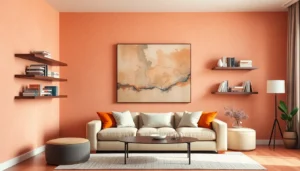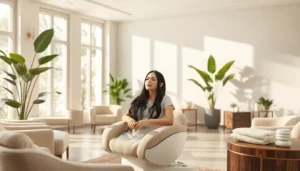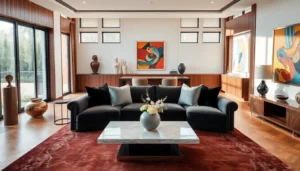Ever walked into a room and felt like it was missing something? That’s probably because the mirrors weren’t working their magic. The art of mirror placement isn’t just about reflecting your fabulous self; it’s about transforming spaces, creating illusions of grandeur, and making even the tiniest rooms feel like a palace.
Imagine strategically placing mirrors to bounce light around, or using them to create depth in a narrow hallway. It’s like giving your space a personality upgrade without the hefty price tag. With the right mirror placement strategy, you can turn your home into a stylish haven that even your reflection will admire! So let’s dive into the world of mirrors and discover how to make every corner shine brighter than your future.
Table of Contents
ToggleUnderstanding Mirror Placement Strategy
Strategically placing mirrors can transform a room’s ambiance. Mirrors reflect light, making spaces feel more open and inviting. The right locations maximize their benefits, enhancing both aesthetics and functionality.
Near natural light sources such as windows, mirrors can amplify brightness. Reflecting outdoor views not only enhances beauty but also brings the outdoors inside. Positioning mirrors across from light sources optimizes illumination throughout the space.
Utilizing mirrors to create depth is a key aspect of interior design. Large mirrors in small rooms create an illusion of spaciousness. Hanging one over a fireplace or in hallways adds dimension and interest.
Placement also plays a crucial role in enhancing decor. Mirrors can serve as focal points or complement existing art pieces. When framed elegantly, they add character and style to a room.
Height affects how mirrors impact a space. Affixing mirrors at eye level allows for optimal reflection. Adjusting placement based on furniture arrangement ensures the mirror serves its purpose effectively.
Consider the overall style of the room when selecting mirror shapes and sizes. Round mirrors soften angular lines in modern decor, while ornate frames enhance traditional settings. Mixing different styles can create visual intrigue but requires careful consideration.
Heightened functionality can be achieved through strategic mirror placement. The entryway can benefit from a full-length mirror for last-minute outfit checks. Similarly, a bathroom might incorporate mirrors that serve dual purposes, such as magnifying and reflecting light.
Lastly, simplicity often yields the best results. Minimalist design advocates placing fewer, larger mirrors instead of multiple small ones. This approach maintains focus and enhances visual clarity in design schemas.
Benefits of Effective Mirror Placement
Effective mirror placement brings numerous advantages to home decor. Properly positioned mirrors can enhance both aesthetics and functionality within a space.
Enhancing Interior Space
Mirrors create the illusion of larger areas in compact rooms, making them feel more open. Large mirrors positioned strategically can serve as focal points, drawing attention and adding elegance to the decor. When placed across from windows or light sources, they reflect visual elements, which increases the feeling of spaciousness. They also enhance room flow by creating a seamless transition between different areas. This technique helps to unify the overall design, allowing for an integrated look throughout the home.
Improving Natural Light
Placing mirrors near natural light sources significantly boosts brightness in any room. They reflect sunlight, making spaces feel warm and inviting. Positioning mirrors opposite windows maximizes this effect, directing light throughout the room. Increased natural light can improve mood and create a more vibrant atmosphere. Additionally, using mirrors to amplify light effects can reduce reliance on artificial lighting, thus saving energy. This thoughtful placement not only enhances ambience but also maintains a fresh and airy feel in every space.
Common Mistakes in Mirror Placement
Several common mistakes can undermine the intended effects of mirrors in home decor. Avoiding these pitfalls ensures optimal aesthetics and functionality.
Poor Positioning
Positioning mirrors incorrectly diminishes their effectiveness. Some individuals place mirrors directly across from doors or walls cluttered with artwork, disrupting visual harmony. Instead, positioning mirrors near windows can enhance natural light reflection. Placing them beside or above furniture creates a cohesive look, while maintaining a soothing flow. Consider also the angle; mirrors angled toward light sources brighten a room significantly. Ideally, positioning large mirrors should allow easy viewing, creating a strategic focal point in the design.
Neglecting Scale and Size
Neglecting the scale and size of mirrors often leads to disproportionate aesthetics. Small mirrors in expansive rooms can appear lost, while oversized mirrors in compact spaces may overwhelm. Choosing a mirror that aligns with furniture and wall dimensions fosters balance. For instance, pairing a large mirror with a spacious sofa achieves a harmonious look. Consider the proportions of surrounding decor; they should complement rather than compete. Opting for fewer, larger mirrors tends to maintain clarity and enhances visual impact throughout the room.
Tips for Implementing an Effective Strategy
Effective mirror placement transforms both aesthetics and functionality in a space. Following specific strategies ensures successful results.
Optimal Locations
Placing mirrors near windows maximizes natural light, allowing sunshine to flood the room. Position mirrors across from doors to create a welcoming entryway. Consider areas that require additional brightness; a strategically placed mirror can enhance dark corners. Hanging mirrors above furniture like sofas or consoles draws the eye, creating a focal point. Also, positioning mirrors in hallways can make narrow spaces feel more open. Mirrors placed at eye level improve personal interaction within a room, enhancing the overall ambiance.
Choosing the Right Mirrors
Selecting the right mirror involves considering room style and size. Round mirrors soften modern spaces, while ornate frames fit traditional decor. Opt for larger mirrors in expansive areas; these can anchor the design and prevent the space from feeling barren. Small mirrors suit compact rooms, ensuring they don’t overwhelm the environment. Assess frame colors to complement existing furnishings, ensuring cohesion in design. Reflective surfaces with a high sheen can amplify light, contributing to an airy feel. Balancing size and style ensures that the mirror enhances rather than detracts from the overall theme.
Mirror placement is a powerful tool in home decor that can dramatically alter the feel of a space. By strategically positioning mirrors, one can enhance light, create depth, and make rooms feel more expansive. It’s essential to consider factors like natural light sources and furniture arrangement to maximize the benefits of mirrors.
Thoughtful selection of mirror styles and sizes can complement existing decor while maintaining balance. Avoiding common mistakes in placement ensures that mirrors serve their intended purpose without disrupting visual harmony. With the right approach, mirrors can transform any room into a brighter and more inviting environment, ultimately elevating the overall aesthetic of the home.






